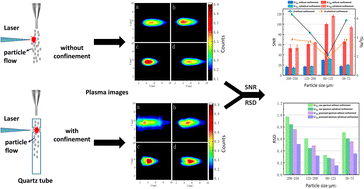An optimization method based on spatial confinement for direct detection of laser-induced particle flow
Abstract
Laser-induced breakdown spectroscopy (LIBS) has the advantages of on-line, rapid and multi-element synchronous detection. It can be applied to real-time and rapid property detection of particle flow. However, the instability of flow greatly affects the quality and stability of laser–material interaction and plasma generation. Therefore, to improve the stability of interaction, a section of a perforated hollow quartz tube was developed and attached to the laser ablation position of particle flow to form a cylindrical spatial confinement for the particle flow and its plasma. The confinement and stabilization effects of the cylindrical spatial confinement were investigated by using plasma images, pulse-to-pulse relative standard deviation (RSD) images and statistical analysis of spectral data. In addition, the effects of the cylindrical spatial confinement in different particle flow scenarios were compared to explore the impact of particle size on the application. The results showed that the cylindrical spatial confinement is effective in confining the particle flow and plasma, but the confinement effect is particle size dependent and the difference would be directly reflected in the improvement amplitude of the signal-to-noise ratio (SNR). In addition, the analysis of pulse-to-pulse RSD images of the plasma and the pulse-to-pulse RSDs of the characteristic emissions showed that the cylindrical spatial confinement can effectively improve the stability of LIBS particle flow detection, and the particle size has no obvious impact on the stability effect of spatial confinement. In general, cylindrical spatial confinement can effectively confine and stabilize the plasma of the particle flow, thus improving the quality of the particle flow spectral signal.

- This article is part of the themed collection: JAAS HOT Articles 2023


 Please wait while we load your content...
Please wait while we load your content...